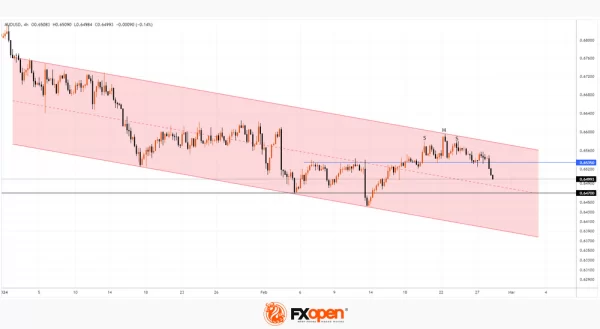According to data published today by the Australian Bureau of Statistics, the Consumer Price Index (CPI) value was: actual 3.4%, expected = 3.6%, a month ago = 3.4%, 2 months ago = 4.3%.
Data shows Australia’s consumer price growth rate is slowing, approaching targets of around 2%. This means less pressure on the Reserve Bank of Australia, which is pursuing tight monetary policy to combat inflation. Thus, the prospect of lower interest rates makes the Australian dollar weaker relative to other currencies.
For example, the reaction to news about inflation in Australia, which was below expectations, was the fall in the price of AUD/USD.
Technical analysis of the AUD/USD chart shows that:
→ the price of AUD/USD continues to develop in a downward channel (shown in red);
→ the price has broken through the important level 0.6535, which served as support since last week, but now, perhaps, will again begin to provide resistance, as it did in the first half of February;
→ in February, a bearish SHS pattern formed.
Bulls can be given hope by:
→ psychological level 0.6500;
→ median line of the red channel;
→ important support 0.647.
Please also note:
→ today at 16:30 GMT+3, US GDP data will be published;
→ tomorrow at 16:30 GMT+3, data on the US PCE inflation index will be published.
Both news have the potential to have a strong impact on the US dollar exchange rate and related markets. Be prepared for spikes in volatility.
Trade over 50 forex markets 24 hours a day with FXOpen. Take advantage of low commissions, deep liquidity, and spreads from 0.0 pips. Open your FXOpen account now or learn more about trading forex with FXOpen.
This article represents the opinion of the Companies operating under the FXOpen brand only. It is not to be construed as an offer, solicitation, or recommendation with respect to products and services provided by the Companies operating under the FXOpen brand, nor is it to be considered financial advice.














